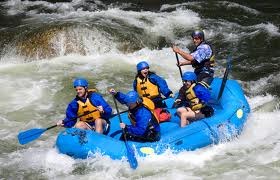Three Monks is a Chinese animated feature film produced by the Shanghai Animation Film Studio. It is also referred to as The Three Buddhist Priests. When the movie starts a note appears in which first column states "one monk fetches water to drink", the second column reads "two monks carry water to drink" and the third one just states, "three monks". To get a better understanding first let us watch the movie.
The movie can be divided into 3 parts:
1. When only one monk is there - We can see that when the monk was alone he used to do the work i.e. bringing the water from the river to the monastery happily. He had no qualms with the way things were moving. In other words he was content with the life he was living or the work he was doing.

2. When another monk joins the first one - The attitude of the first monk changes drastically when the second monk joins him in the monastery. Initially he intimidated him into bringing water from the river but after some time the newbie monk demand equal distribution of work. This altercation resulted in loss of man hours as well as gloomy atmosphere in the monastery. After lot of deliberation, they decide to share the responsibility and once they started sharing the job, their productivity also increased. We can see that the method adopted in this case is much better then used in the previous one.
3. When the third monk joins the other two - Initially the same thing happened wherein the veterans forced the newcomer into work. After sometime it was total chaos in the monastery with none of the monks willing to go to the river to get the water. One fine day when fire breaks in the monastery then all the three monks work together in tandem thereby giving fruitful results. The method in this case is superior to the methods used in case 1 and case 2 as it involves active participation of all the resources.
Learning
The movie teaches us a lot of managerial lessons. I have listed down few of them:
1. Team work - The work which could have been done very easily had they worked as team took a toll on them. As we have seen in case of emergency (monastery catching fire), they worked as a team and got the desired results very easily. The manager has to ensure that the employees are working in a team, individuality hinders the progress of a firm. Team work can do wonders. In my last blog also I had shared a video on team work, this time have a look at this video:
2. Job distribution - The situation can be compared to an organisation which has all the resources in the world but is not able to utilise them properly. In the movie even with three monks (resources), water (end result) was scarce in the monastery. It is responsibility of the manager to utilise the resources provided to him optimally. As we can see in the end the monks divides the job and get the desired result very effectively and easily.
3. Innovation - There are two ways of completing a job, one is monotonous conventional method which every body follows and the other one being innovative method. In the movie the monks could have very well adopted conventional approach (three monks standing at regular intervals) to get the water, but it would have been very tiresome as well as time consuming. Thus they went for innovative idea of placing a pulley thereby reducing the mechanical effort one has to put in which in turn increased their productivity. In a company the manager has to be a Theory Y manager, always pushing the employees for new ideas, always having faith in the man power assigned to him. If the manager backs the employee then only employee can come out with a new and innovative idea. Innovation can be continuous (over a period of time), can be drastic (out of the exigency). The one which we had seen in the movie is drastic. But we should always aim for continuous innovation. If the innovation is continuous then it will be flawless because sufficient amount of time and thought process would have invested in that idea, whereas drastic innovations arises out of the emergency situation.
What you have to say about this?
4. Crisis management - In the movie when the temple catches fire all the three monks work together as a team and gets out of the crisis situation. There are times when people looses their cool during emergencies. A manager must always keep a clam composure no matter what the situation is. In case of emergency, the manager should adopt a rationale thinking in getting the team of the emergency situation. He should be in a position to assign different employees in different roles so as to counter the exigencies.
An organisation can flourish only if it has cordial atmosphere as well as convivial employees. If the manager is able to bind the team together jovially, there is no stopping to the company. In the movie the same set of people were fighting against each other but circumstances changed them and the same set of people started working together and with increased productivity. The manager in a company must ensure that the employees are not dependent on emergency situation to come together and work as a team, they should work in coordination from the moment they join the team.









